Roofing Companies Littleborough
Best Roofing Services in Littleborough
Get multiple Roofing Companies quotes for your project today! Compare profiles, reviews, accreditations, portfolio, etc... and choose the best service.
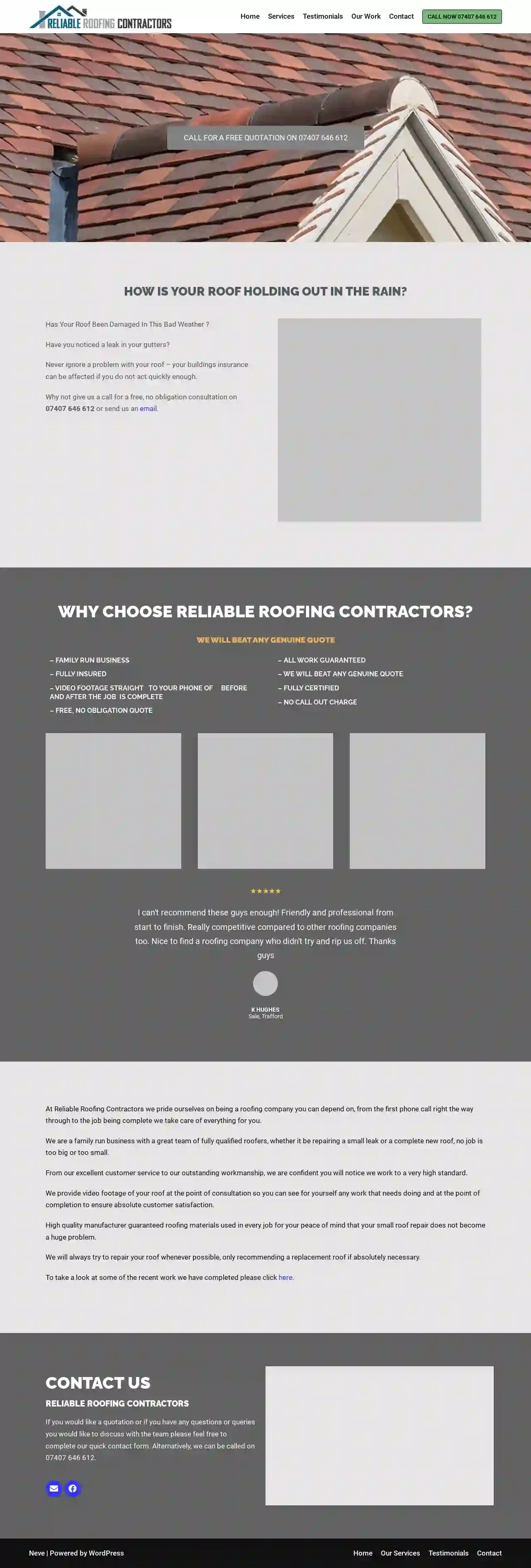
Reliable Roofing Contractors
GBAt Reliable Roofing Contractors, we're a family-run business dedicated to providing top-notch roofing services you can trust. Our team of fully qualified roofers is ready to handle any project, big or small, from repairing a minor leak to installing a brand new roof. We pride ourselves on our exceptional customer service and outstanding workmanship, ensuring your complete satisfaction every step of the way. We understand the importance of transparency, which is why we provide video footage of your roof during both the consultation and completion stages. This allows you to see exactly what needs to be done and the quality of our work firsthand. We use only high-quality, manufacturer-guaranteed roofing materials in every job, giving you peace of mind that your roof repair won't become a bigger problem down the line. We always prioritize repairs whenever possible, recommending a replacement roof only when absolutely necessary. To see examples of our recent work, please visit our 'Our Work' page. For a free, no-obligation quote or to discuss your roofing needs, don't hesitate to contact us. You can reach us by phone at 07407 646 612 or fill out our quick contact form.
- Services
- Why Us?
- Testimonials
- Gallery
Get Quote
Roofcraft Roofing Services
574 reviewsBolton, 123 Main St, BL1 2AB, GBRoofcraft Roofing Services is a trusted Bolton Roofer with over 40 years' experience in all manners of roofing. From flat roofs to pitched, insulation to roof repairs, you won't find better roofers anywhere in the North West. We pride ourselves as being a leading roofer in Bolton and the surrounding areas, our prices are yet to be beaten and we have fantastic customer feedback. From your initial meet with our team, we give you a fantastic service to the very end of job completion. No job is too big or small. Roofcraft Roofing Services are friendly, efficient, reliable, and honest. Your roofs are safe in our hands!
- Services
- Why Us?
- Our Team
- Testimonials
- Gallery
Get Quote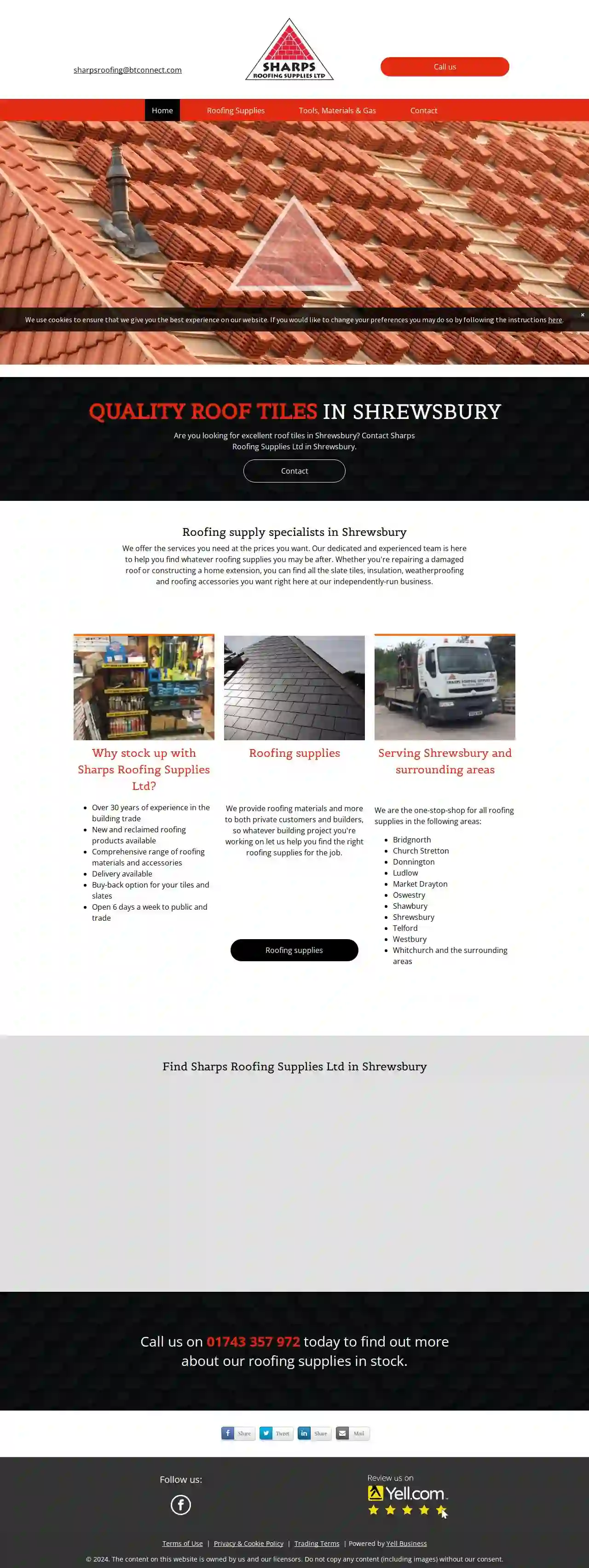
Sharps Roofing Supplies Ltd
4.943 reviews292 Monkmoor Road, Maverick Business Centre, Shrewsbury, SY2 5TF, GBSharps Roofing Supplies Ltd is a family-run business based in Shrewsbury, Shropshire, with over 30 years of experience in the building trade. We offer a comprehensive range of new and reclaimed roofing materials and accessories, catering to both private customers and builders. Our dedicated team is committed to providing expert advice and helping you find the perfect roofing supplies for your project, whether it's a roof repair or a home extension. We pride ourselves on our extensive stock, competitive prices, and exceptional customer service. Our commitment to quality and customer satisfaction has made us a trusted name in the roofing industry. At Sharps Roofing Supplies Ltd, we understand the importance of finding the right materials for your roofing needs. That's why we offer a wide selection of products, including slate tiles, insulation, weatherproofing, and more. We also provide a buy-back option for your tiles and slates, ensuring responsible disposal and potential cost savings. Conveniently located in Shrewsbury, we serve a wide area, including Bridgnorth, Church Stretton, Donnington, Ludlow, Market Drayton, Oswestry, Shawbury, Telford, Westbury, Whitchurch, and surrounding areas. Contact us today to discuss your roofing requirements and let our experienced team help you find the perfect solutions.
- Services
- Why Us?
- Gallery
Get Quote
Northwest Roofing
510 reviewsBurnley, GBNorthwest Roofing Specialists is a professional and fully insured roofing company operating in and around the Burnley Lancashire area. We offer FREE quotes and are committed to providing superior quality and results. Our team is certified in best safety practices and we follow strict safety procedures to ensure a safe working environment. We provide a range of services including industrial roofing, new roof build design, commercial roofing, solar panel installation, and residential roof repair. Our mission is to provide honest pricing and obligation-free quotes, ensuring that our customers know exactly what they will pay for the service they receive.
- Services
- Why Us?
- Testimonials
- Gallery
Get Quote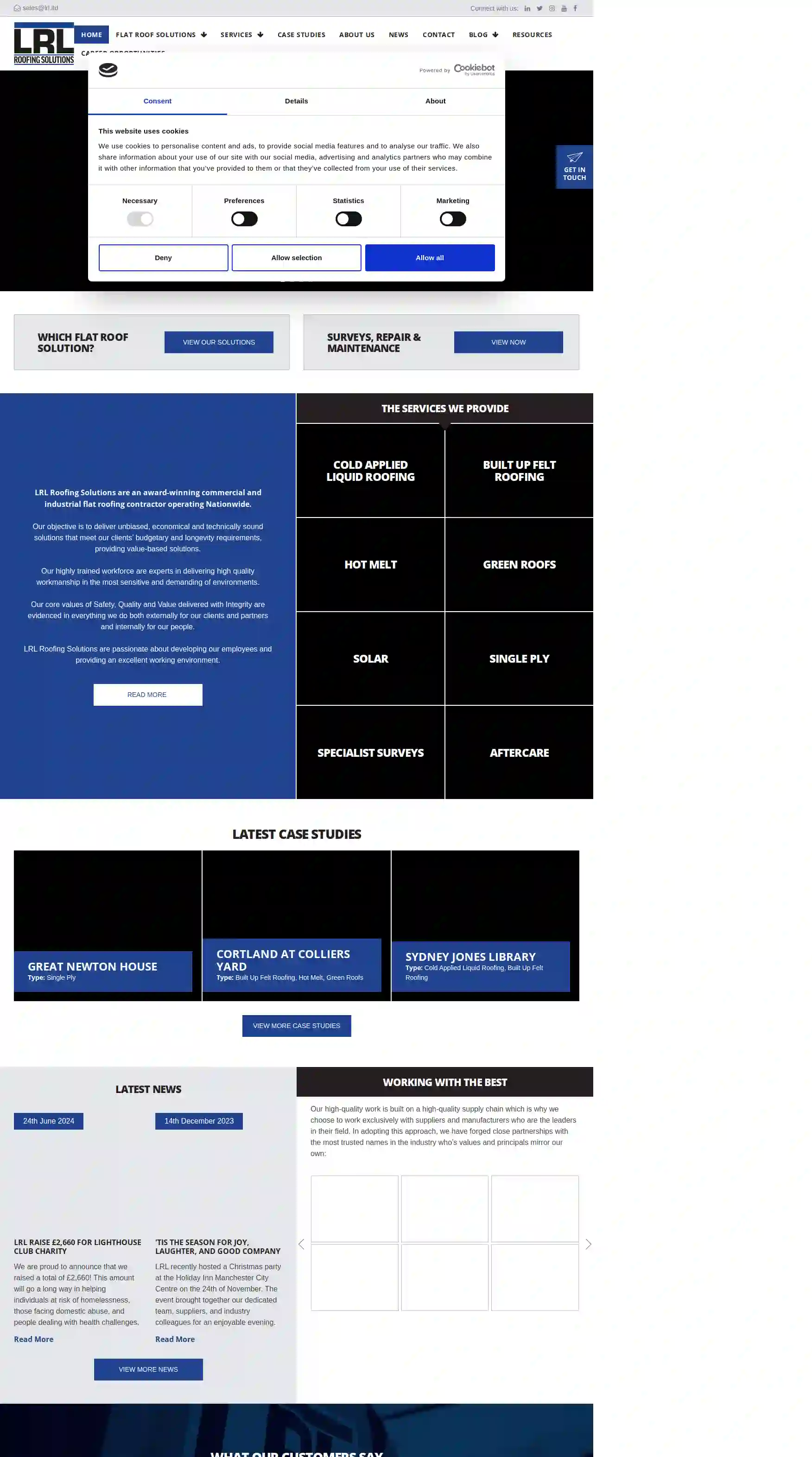
LRL Roofing Solutions
4.84 reviewsGBLRL Roofing Solutions are an award-winning commercial and industrial flat roofing contractor operating Nationwide. Our objective is to deliver unbiased, economical and technically sound solutions that meet our clients’ budgetary and longevity requirements, providing value-based solutions. Our highly trained workforce are experts in delivering high quality workmanship in the most sensitive and demanding of environments. Our core values of Safety, Quality and Value delivered with Integrity are evidenced in everything we do both externally for our clients and partners and internally for our people. LRL Roofing Solutions are passionate about developing our employees and providing an excellent working environment.
- Services
- Why Us?
- Accreditations
- Our Team
- Testimonials
Get Quote
Eurocell
4.712 reviewsBury, GBEurocell is a leading manufacturer of PVCu building products, offering a wide range of products for the construction industry. Our products include fascias, soffits, capping boards, composite decking, fencing, doors, windows, and more. We provide high-quality products and expert advice to help you complete your building project. Contact us today to learn more.
- Services
- Why Us?
- Accreditations
- Gallery
Get Quote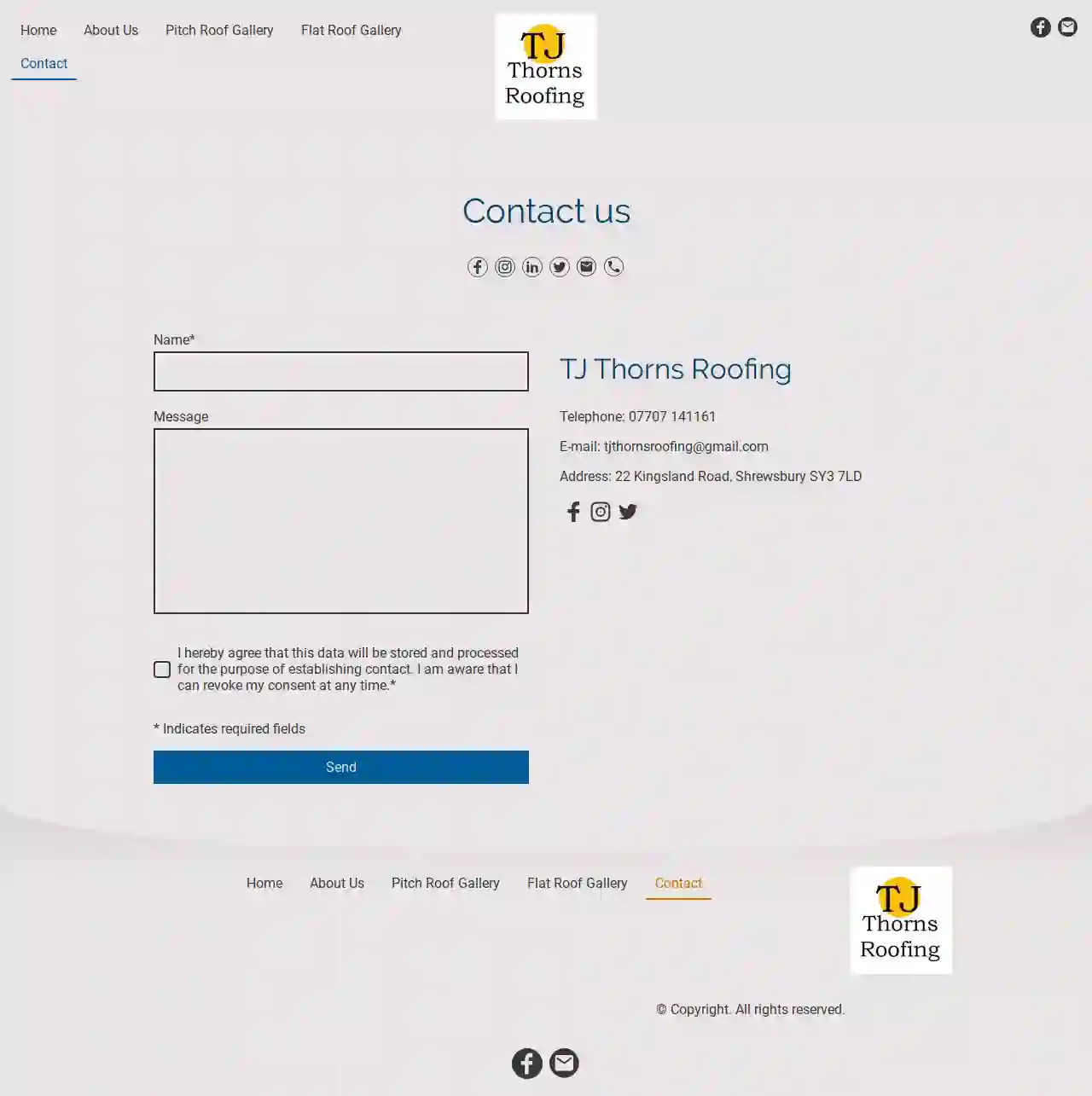
TJ Thorns Roofing
22 Kingsland Road, Shrewsbury, SY3 7LD, GBTJ Thorns Roofing commenced trading in 2018 and is owned and operated by Tom Thorns in Shrewsbury, Shropshire. Tom is 30 years old and has been working in the roofing trade for 13 years alongside many other contractors and building trades. Tom has completed and passed a 2 year NVQ Roofing Course at the National Construction College in Birmingham. Tom was nominated for the apprentice of the year in each of those years and passed as framework achiever. Our Service to You We cover all aspects of roofing work with the key elements noted below We would be pleased to offer a free no obligation quotation for any project, large or small Slate Roofing The majority of our work includes the use of welsh, spanish, chinese, cement fibre and composite slates. This is one of the most popular roofing styles in Shropshire Tile Roofing We work with all types of tiles including clay and concrete tiles. Flat Roofing Systems We are a registered installer of the 'Cure It' GRP fibreglass roofing system which has a 20 year guarantee. 'Cure It' is the country's leading GRP flat roofing material manufacturer We can also use 'Firestone' Rubber Cover EPDM which is a high performance rubber membrane offering a watertight and durable roofing solution Leadwork As part of our roofing works we regularly provide leadwork We can provide step and cover flashings, back gutters, front aprons, lead hips, soakers and dormer coverings We can also provide lead roofs to dormers if that's the clients preference
- Services
- Why Us?
- Our Team
- Gallery
Get Quote
MC Roofing Services
511 reviewsGBSpecialising in all aspects of pitched and flat roofing, the MC Roofing Services team are efficient, tidy, reliable and have 15 years’ experience. Working on small projects to large, MC Roofing Services will give you 100% satisfaction. We always keep our customers up to date on progress and will go above and beyond to meet your needs. We pride ourselves on paying particular attention to detail, ensuring work is completed to the highest standard. We cover Salisbury and the surrounding areas. Read our Reviews Follow us on Instagram to view more of our work
- Services
- Why Us?
- Our Team
- Testimonials
- Gallery
Get Quote
T K Roofing
52 reviews26 Scarlin Road, Bury St Edmunds, IP33 2HX, GBTK Roofing (Suffolk) Ltd are experienced roofers based in Bury St Edmunds, offering comprehensive roofing services for all types of roof work. From roof repairs and maintenance to complete roof replacement, we can meet all your roofing needs. Our skilled and professional roofing contractors work with residential and commercial clients across Bury St Edmunds, Newmarket, Stowmarket, Thetford, Sudbury and the surrounding areas of Suffolk.
- Services
- Why Us?
- Our Team
- Testimonials
- Gallery
Get Quote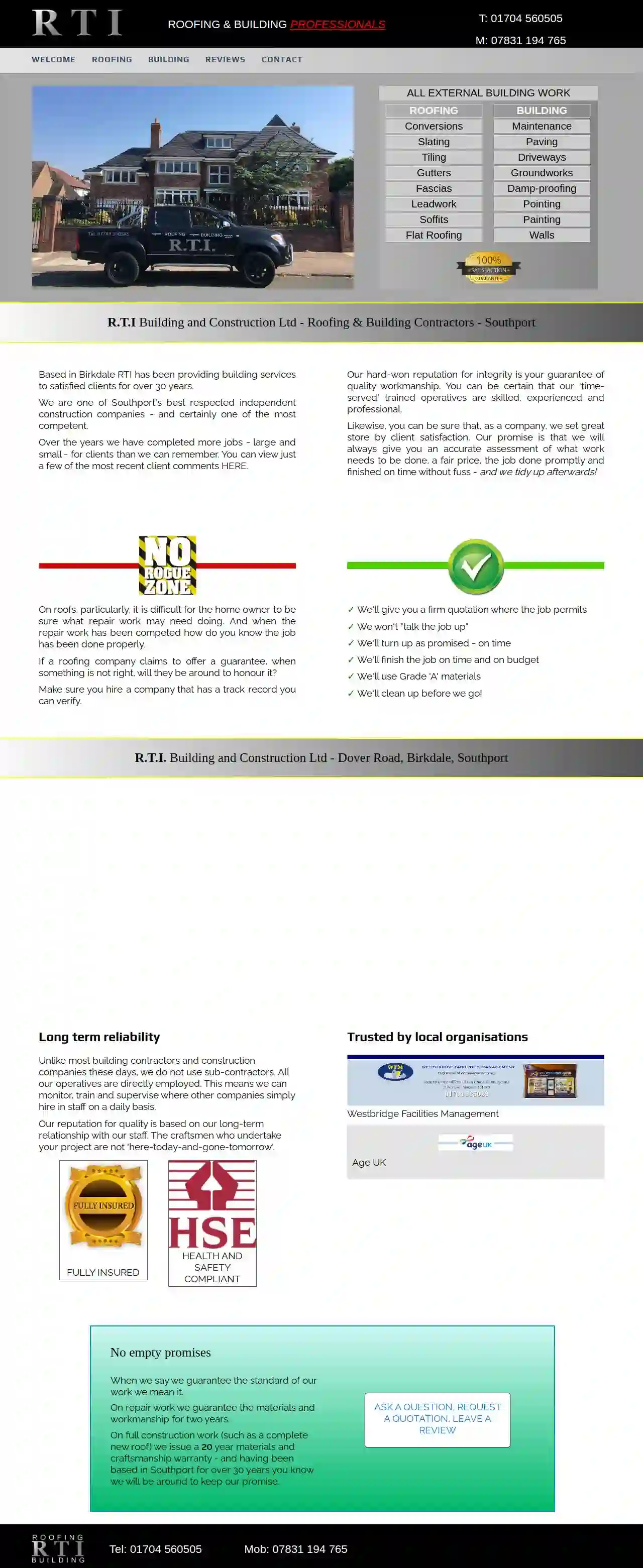
rooferssouthport.com
Birkdale, Dover Road, Southport, PR8 3LA, GBR.T.I Building and Construction Ltd - Roofing & Building Contractors - Southport Based in Birkdale RTI has been providing building services to satisfied clients for over 30 years. We are one of Southport's best respected independent construction companies - and certainly one of the most competent. Over the years we have completed more jobs - large and small - for clients than we can remember. You can view just a few of the most recent client comments HERE. Our hard-won reputation for integrity is your guarantee of quality workmanship. You can be certain that our 'time-served' trained operatives are skilled, experienced and professional. Likewise, you can be sure that, as a company, we set great store by client satisfaction. Our promise is that we will always give you an accurate assessment of what work needs to be done, a fair price, the job done promptly and finished on time without fuss - and we tidy up afterwards! On roofs, particularly, it is difficult for the home owner to be sure what repair work may need doing. And when the repair work has been competed how do you know the job has been done properly. If a roofing company claims to offer a guarantee, when something is not right, will they be around to honour it? Make sure you hire a company that has a track record you can verify. ✓ We'll give you a firm quotation where the job permits ✓ We won't "talk the job up" ✓ We'll turn up as promised - on time ✓ We'll finish the job on time and on budget ✓ We'll use Grade 'A' materials ✓ We'll clean up before we go! R.T.I. Building and Construction Ltd - Dover Road, Birkdale, Southport Long term reliability Unlike most building contractors and construction companies these days, we do not use sub-contractors. All our operatives are directly employed. This means we can monitor, train and supervise where other companies simply hire in staff on a daily basis. Our reputation for quality is based on our long-term relationship with our staff. The craftsmen who undertake your project are not 'here-today-and-gone-tomorrow'. FULLY INSURED HEALTH AND SAFETY COMPLIANT Trusted by local organisations Westbridge Facilities Management Age UK No empty promises When we say we guarantee the standard of our work we mean it. On repair work we guarantee the materials and workmanship for two years. On full construction work (such as a complete new roof) we issue a 20 year materials and craftsmanship warranty - and having been based in Southport for over 30 years you know we will be around to keep our promise. ASK A QUESTION, REQUEST A QUOTATION, LEAVE A REVIEW Tel: 01704 560505 Mob: 07831 194 765
- Services
- Why Us?
- Accreditations
- Our Team
- Testimonials
- Gallery
Get Quote
Over 12,314+ Roofing Businesses on our platform
Our roofing pros operate in Littleborough and surrounding areas!
Roofyng.co.uk has curated and vetted Top Roofers arround Littleborough. Find the most trustworthy contractor today.
Frequently Asked Questions About Roofing Companies
- Home Improvement Loans: Offered by banks or credit unions.
- Home Equity Loans or Lines of Credit: Use your home's equity as collateral.
- Government Programs: Check for energy efficiency rebates or grants.
- Contractor Financing: Some roofing companies offer financing plans.
- Experience: Companies with a solid track record and years of experience in the industry.
- Licensing and Insurance: Verify they are properly licensed to operate in your area and carry adequate insurance to protect you from liability.
- Certifications: Look for certifications from reputable organizations, demonstrating expertise in specific roofing materials or techniques.
- Positive Reviews: Check online reviews and testimonials from previous customers.
- Professionalism: Choose a company that communicates clearly, provides detailed estimates, and has a courteous and responsive team.
- Safety First: Avoid going onto the roof during a storm, as it's dangerous.
- Document the Damage: Take photos and videos of the damage for insurance purposes.
- Contact Your Insurance Company: Report the damage to your insurance company as soon as possible to initiate a claim.
- Temporary Repairs: If safe, address any immediate leaks using buckets or tarps to minimize further damage.
- Contact a Roofing Contractor: After the storm, have a qualified roofing contractor inspect the roof and provide a repair estimate.
- Age: If your roof is nearing or exceeding its expected lifespan, it's wise to consider replacement.
- Multiple Leaks: Several leaks or leaks that reappear after repairs suggest a widespread problem.
- Extensive Damage: Large areas of damaged, missing, or deteriorated roofing materials might be too costly or difficult to repair effectively.
- Sagging or Structural Issues: Sagging, deflection, or other structural issues indicate a compromised roof that needs replacement.
- Granule Loss (Asphalt Shingles): Significant granule loss indicates weathering and reduced protection.
- Curling or Buckling Shingles: Signifies age or improper ventilation.
- Increased Energy Bills: A poorly insulated roof can lead to higher heating and cooling costs.
How can I get financing for a new roof?
How do I find a good roofing company?
What should I do if my roof is damaged in a storm?
What are the signs that my roof needs to be replaced?
How can I get financing for a new roof?
- Home Improvement Loans: Offered by banks or credit unions.
- Home Equity Loans or Lines of Credit: Use your home's equity as collateral.
- Government Programs: Check for energy efficiency rebates or grants.
- Contractor Financing: Some roofing companies offer financing plans.
How do I find a good roofing company?
- Experience: Companies with a solid track record and years of experience in the industry.
- Licensing and Insurance: Verify they are properly licensed to operate in your area and carry adequate insurance to protect you from liability.
- Certifications: Look for certifications from reputable organizations, demonstrating expertise in specific roofing materials or techniques.
- Positive Reviews: Check online reviews and testimonials from previous customers.
- Professionalism: Choose a company that communicates clearly, provides detailed estimates, and has a courteous and responsive team.
What should I do if my roof is damaged in a storm?
- Safety First: Avoid going onto the roof during a storm, as it's dangerous.
- Document the Damage: Take photos and videos of the damage for insurance purposes.
- Contact Your Insurance Company: Report the damage to your insurance company as soon as possible to initiate a claim.
- Temporary Repairs: If safe, address any immediate leaks using buckets or tarps to minimize further damage.
- Contact a Roofing Contractor: After the storm, have a qualified roofing contractor inspect the roof and provide a repair estimate.
What are the signs that my roof needs to be replaced?
- Age: If your roof is nearing or exceeding its expected lifespan, it's wise to consider replacement.
- Multiple Leaks: Several leaks or leaks that reappear after repairs suggest a widespread problem.
- Extensive Damage: Large areas of damaged, missing, or deteriorated roofing materials might be too costly or difficult to repair effectively.
- Sagging or Structural Issues: Sagging, deflection, or other structural issues indicate a compromised roof that needs replacement.
- Granule Loss (Asphalt Shingles): Significant granule loss indicates weathering and reduced protection.
- Curling or Buckling Shingles: Signifies age or improper ventilation.
- Increased Energy Bills: A poorly insulated roof can lead to higher heating and cooling costs.